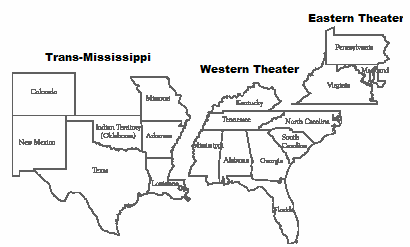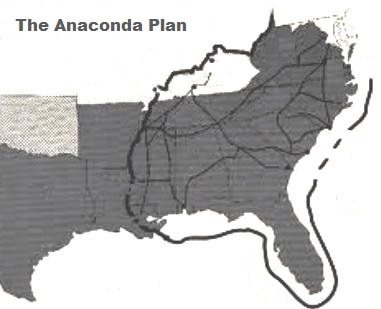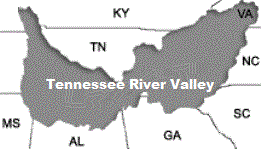| Definition of Anaconda Plan
Definition: The Anaconda Plan was the name given to the military strategy, designed by General Winfield Scott and the leaders of the Union forces. The objective of the Anaconda Plan was to establish a full Naval Blockade around the coastline of the Southern States and gain control of the Mississippi River (see the map of the Anaconda Plan). The planned blockade would stop trade in the South, preventing the import of necessary provisions and supplies and cutting off the export trade that provided the South with money. Anaconda Plan
Abraham Lincoln was the 16th American President who served in office from March 4, 1861 to April 15, 1865. The key event during his presidency was the American Civil War and this article provides details of the famous Anaconda Plan designed for the Union by General Winfield Scott, the conqueror of Mexico. |
|
Map of the Anaconda Plan
The Map of the Anaconda Plan provides a graphic representation of the strategy suggested by the Union leaders. The plan was an outline for the military to focus on although it was never officially adopted by the Union. Elements of the Anaconda Plan were therefore employed at different time throughout the course of the war. Map of the Anaconda Plan: The Theaters of War
The Map of the Anaconda Plan should also be considered in relation to the principal Theaters of the Civil War in which the major military operations took place. These were divided into the Western Theater and the Eastern Theater with the Trans-Mississippi area as another minor theater. The Theaters of War Map 
| 
| The Anaconda Plan: Passive then Aggressive
The Anaconda Plan Map explains the nickname given to this military strategy. The adoption of the strategy was to crush the life out of the Confederacy, just as the lethal anaconda snake uses constriction to subdue their prey. The proposal was described as the means "to squeeze the South to military death". Its intention was to demoralize the South by starving them out using the blockade tactic forcing the Southerners to surrender and return to the Union. Elements of the Anaconda Plan were at first criticized as being too passive, but it reappeared in aggressive form when General William T. Sherman employed the destructive "scorched earth policy" during his March to the Sea following the capture of Atlanta. |
The Purposes of the Anaconda Plan - 4 Parts
The Anaconda Plan had several aims, goals and purposes that could be described in 4 parts: The 4 Parts of the Anaconda Plan | | | | Part 1 of the Anaconda Plan: | To establish a naval blockade around the whole coast of the South in order to prevent the export of cotton, indigo, tobacco, and other cash crops from the South and to keep the South from importing essential war supplies and provisions | | | | Part 2 of the Anaconda Plan: | To divide the South by controlling the Mississippi River and cutting the South off from the west, as shown in the Map of the Civil War Trans-Mississippi and Western theaters of war | | | | Part 3 of the Anaconda Plan: | To further divide the South by capturing the Tennessee River Valley and marching through Georgia to the Atlantic coast | | | | Part 4 of the Anaconda Plan: | To capture Richmond, Virginia, located in the Eastern Theater of War and the home of a great arsenal and armory for the Confederate States Army. As Richmond was also the capital of the Confederate States of America its capture would be a devastating psychological blow to the South |
Anaconda Plan: The Passive Strategy
The Anaconda Plan, described initially as a passive strategy as it was devised to weaken the South without invading it. The strategy would take time and patience to put into effect. The key to the Anaconda Plan was to establish a blockade to prevent goods leaving or entering the southern states. To put this into practice required the Union to mount a blockade covering more than 3,000 miles of coast from Virginia, North Carolina, South Carolina, Georgia, Florida and all the way up the waterways of the Mississippi. Anaconda Plan: Part 1 - The Blockade
The Anaconda Plan started to be put into place when President Abraham Lincoln ordered the Union blockade of the Confederate seaports on April 19, 1861, just six days after the fall of Fort Sumter. The blockade was a highly effective tactic of the Anaconda Plan. As time passed the blockade became stricter and tighter, causing immense hardship by depriving the Southerners of many supplies. The blockade prevented the South from sending their products to Europe, blocking their cash flow. Goods could only be paid for in gold and silver from the blockade runners. Before long was no more gold and silver in the Confederate States of America, and paper money took its place. Supplies of manufactured goods that were not produced in the South ran out. The Southerners were unable to buy clothes, food, salt, coffee or medicines. They were unable to manufacture arms and ammunition for the Southern soldiers. The Blockade Policy suggested in the Anaconda Plan was highly effective and wore down the resistance of the people of the Confederacy. Anaconda Plan: Part 2 - The Mississippi and the Battle of Vicksburg
The Anaconda Plan allowed for the strategic importance of the location of the Mississippi River. The heavily fortified city of Vicksburg was the doorway to the Mississippi River. The capture of Vicksburg by the Union by the North would enable the movement of Northern troops and supplies into the very heart of the South. With this aspect of the Anaconda Plan in mind, General Ulysses S. Grant led the highly successful Vicksburg Campaign and Victory for the North at the Battle of Vicksburg (May 18, 1863 - July 4, 1863) which effectively resulted in the Union gaining control of the Mississippi River. |
Anaconda Plan Part 3 - Tennessee River Valley, Forts Henry & Donelson
The Anaconda Plan also centered on the vast area known as the Tennessee River Valley and the Cumberland and Tennessee Rivers. Transport systems in the region was particularly effective for the distribution of resources due to its central location, as shown on the map, and also because it was served by 5 railroads. The Tennessee River Valley was also the location of the second largest ironworks of the South in Clarksville, Tennessee. In 1861 the Nashville Ordnance Depot was established as an arsenal and armory, housing a gun factory and storing artillery, firearms and gunpowder. In February 1862 Union troops under the command of General Ulysses S. Grant gained important victories at Fort Henry and Fort Donelson again proving the worth of the Anaconda Plan. The Confederate surrender of Fort Henry opened the Tennessee River to Union traffic and Grant was able to destroy Confederate shipping and railroad bridges upriver. The fall of Fort Donelson opened up the Cumberland River and the 2 major water transportation routes in the west of the Confederacy became Union highways for moving troops and supplies. | 
Tennessee River Valley Map |
Anaconda Plan: Part 4 - Richmond, Virginia
Part 4 of the Anaconda Plan centered around the politically strategic Richmond, the capital of the Confederacy. Many attempts had been made to capture Richmond but the Union force, led, once again, by General Ulysses S. Grant finally occupied Richmond in April 1865. It was a devastating blow and lead to the final surrender of the Confederacy on April 9, 1865. Anaconda Plan - President Abraham Lincoln Video
The article on the Anaconda Plan provides an overview of one of the major strategies of his presidential term in office. The following Abraham Lincoln video will give you additional important facts and dates about the political events experienced by the 16th American President whose presidency spanned from March 4, 1861 to April 15, 1865. | | |
| |
|